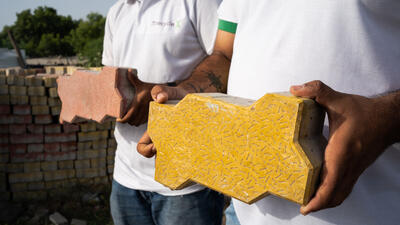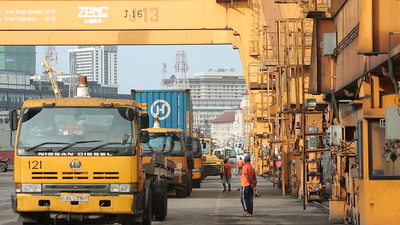A strategy to support development in the Pacific
Thirty young training participants from Moturiki Island were engaged in using traditional techniques and local materials to build ‘bures’ (local-style shelters) for an ecotourism destination. © South Pacific Tourism Organisation
The isolated nature of the Pacific islands imposes numerous challenges that make it difficult for them to trade effectively and, as a consequence, limits the benefits that these islands can derive from regional and global trade agreements.
Pacific island countries are not only small, but they are also isolated from major markets. In trade, this is a challenging combination as market size and distance often determine costs, and in turn influence a country’s competitiveness. To take advantage of the few economic opportunities that can overcome the twin challenges of size and isolation, the trade capacity of Pacific island economies needs to be especially innovative and resilient. In a context where resources are few and narrowly concentrated, Aid for Trade can help fill the gap between capacity needs and new investment, and assist in overcoming barriers to trade.
For small island economies in the Pacific, a coordinated approach to Aid for Trade has the potential to address the supply-side constraints as well as assist in increasing exports of goods and services, allowing the Pacific islands to be part of regional and global value chains.
The first Pacific Aid-for-Trade strategy was developed in 2009 and has proven to be a valuable tool for the mobilization of resources. It has since served as a guiding document for the prioritization of needs against available resources and for the implementation of regional Aid-for-Trade programmes.
The Pacific region is currently revising its regional Aid-for-Trade strategy, with an amended strategy for 2013-2017 being prepared. It will contain the current priorities of the region and will be periodically updated to reflect new mandates, adjustments to the interventions, and the changing trade landscape.
The strategy contains substantive policies outlining the challenges and setting out the potential for increased trade for Pacific economies. It aims to build consensus on the priorities for ensuring growth and a more diversified regional economy. The ultimate goal of the strategy is to outline a coherent approach to resource mobilization, one that sends a strong signal to investors and international development partners, asserting that the region has a clear sense of its needs and that it can coordinate existing and future resources for trade and investment.
The revised Pacific Aid-for-Trade strategy seeks to facilitate trade expansion in the region through four specific objectives: improving trade-related infrastructure; increasing productive capacity for trade; promoting trade-related adjustment; and improving institutional capacity for trade policy and regulations. To effectively address the barriers inhibiting the region’s ability to increase its competitiveness, reduce inefficiencies and enhance the beneficial opportunities found in regional economic integration arrangements, the core objectives of improving trade-related infrastructure and increasing productive capacity for trade will be the priority.
Economies and development partners in the Pacific recognize that if the region is to have a realistic chance of effectively integrating into the global trading system, then they need to have an Aid-for-Trade strategy that strategically prioritizes immediate regional Aid-for-Trade objectives and interventions.
The development of infrastructure in the region to support internal and external trade has become the highest priority. The high cost of international transportation makes many exports uncompetitive, and gaps in domestic infrastructure increase the cost of goods at the border. The impact of natural disasters and climate change on the trade-related infrastructure for key economic sectors such as agriculture, fisheries and tourism can have a detrimental impact on the future viability and sustainability of these exports.
The strategy acknowledges that a major Aid-for-Trade effort must be undertaken to tackle the weaknesses and gaps in trade-related infrastructure in the Pacific islands. The focus is on changes to physical infrastructure, as well as to the soft infrastructure such as the government systems and facilities that are often charged with managing key aspects of trade-related infrastructure.
Export creation requires that we prioritize investments in productive capacity for trade. Access to new markets is necessary, but it is not sufficient to ensure export-led growth. Pacific island economies want to develop and diversify their exports, both in terms of products and services, and markets. To truly harness open markets, integrate into global value chains, and seize new (or niche) opportunities, firms and citizens will need to overcome information barriers, distance and high trading costs. The Pacific Islands Trade & Invest network of offices is present in key international markets of interest to the region to actively promote Pacific exports and tourism, and to support inward investment flows.
A particular focus of economic development is on harnessing the potential of young entrepreneurs, women and traditional or culture-based activities. Pacific peoples and their rich cultures are an important asset. Future investments should also place a marked emphasis on improving the human resources of the region, in appropriately skilling the workforce, and in developing options for improved labour mobility that can contribute to economic prosperity and sustainable development of the Pacific islands.
The development of the revised Pacific Aid-for-Trade strategy recognized that national efforts to mainstream Aid for Trade needed to be complemented by a comprehensive, refreshed regional framework. Such a framework should create a fundamental nexus between aid and trade priorities and long-term economic development objectives. Within this context, consolidating the Aid-for-Trade needs of the region into a single coherent document provides a solid foundation for collaboration between the island states, and the international development partners and investors who have an interest in supporting the Pacific region’s development.
The renewed and refreshed Pacific Aid-for-Trade strategy will support development in the Pacific region through a coordinated partnership approach.















